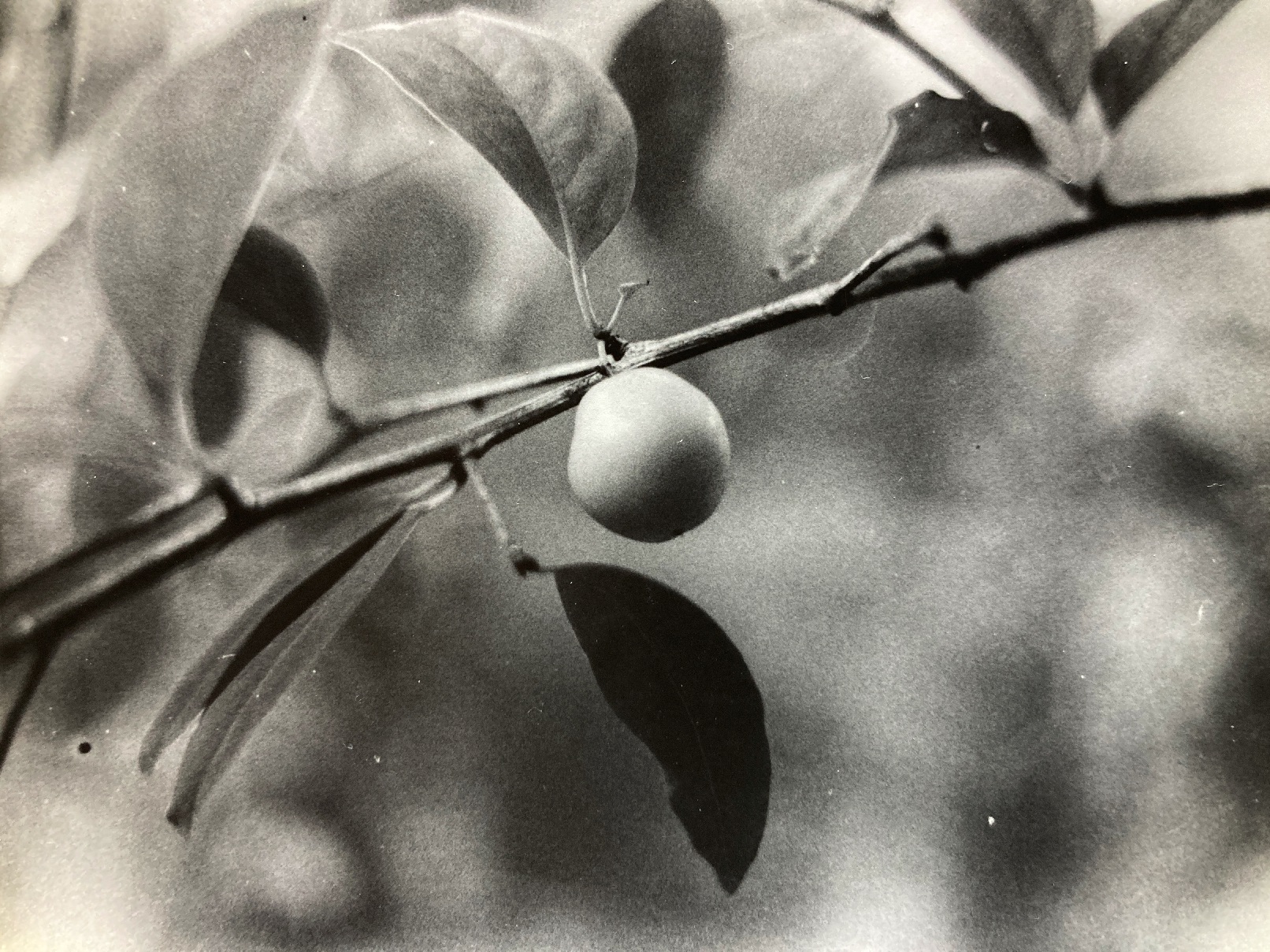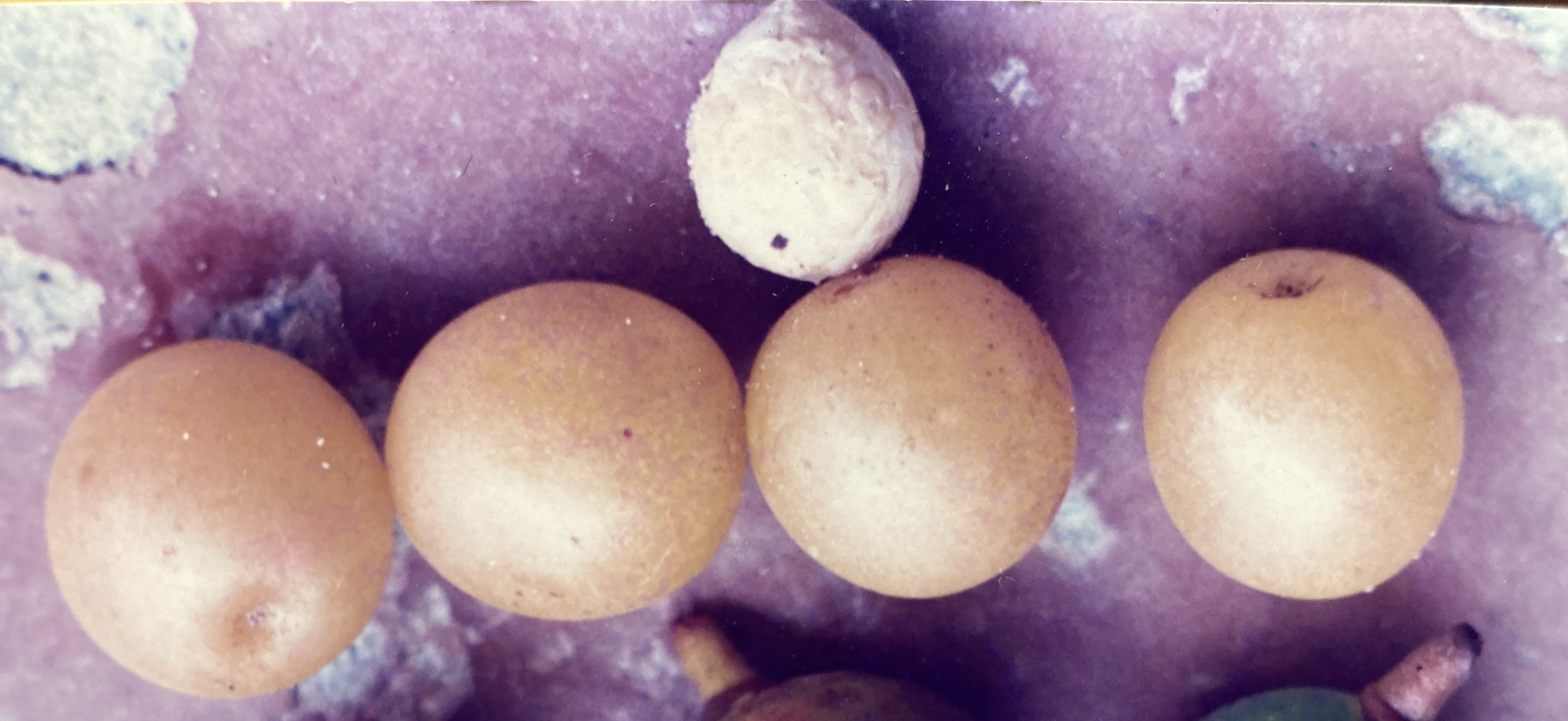Ximenia americana L.
Olacaceae
MELONCILLO, PEPENANCE, (HOG PLUM)
Evergreen shrub (2-4 m) common along the vegetated fringe of the Espadilla Sur beach, Meloncillo thrives only in the immediate coastal zone, where sandy soils and salt-laden air make growing conditions difficult. Ximenia is a parasitic plant, whose roots tap into those of other, nearby species. Nearly spherical, orange or yellow drupes appear on Meloncillo’s branches late in the dry season, and these have a sweet – though somewhat bitter – flavor.
Description: Meloncillo is really a woody shrub, having multiple, grey-barked trunks (8 cm) that emerge in clusters from the soil. Branching is profuse, and the mass of long, straggly limbs form a tangled and inpenetrable thicket along the edge of the sea. Resembling Bouganvillea shoots, the extended branches follow vertically arcing trajectories, but finally drooping towards the ground under the burden of their own weight. Occassional spines are found growing in the leaf axils of the twigs. Meloncillo leaves (7 by 3.5 cm, on 0.5 cm petioles) are simple and alternately arranged. Thick and waxy-smooth, they are crisp and brittle – snapping readily when bent too far. The blades are wavy or ondulating and their color is an anemically pale, yellow-green. (In another plant, this sickly hue might be a symptom indicative of nitrogen-deprivation). New foliage is produced in January, and this event marks the beginning of the annual fertility cycle.
Flowers are yellow (or sometimes almost white), small (8 by 6 mm), and fuzzy. They occur in leaf axils on small panicles that bear from 5 to 10 blossoms each. Four petals dominate each blossom, and they meet at right angles near the base of the flower, where they form a unique, box-shaped corolla. (Sepals are tiny and are located below this structure). Smooth and green outside, the petals themselves have a yellow and distictly hairy inner surface. The presence of these unusual cilia give the blossom a notably silky appearance. Eight stamens – with long, 2mm anthers – are concealed inside the fuzzy interior of the corolla, along with the single, central pistil. Flowering in Meloncillo is a well synchronized and precisely timed annual event. Appearing during the second week of February, blossoms last through March and sometimes linger into early April.
Fruits develop as green, nearly spherical, sessile drupes. After reaching a diameter of 3.5 cm, they ripen and change color, acquiring a bright orange-yellow hue. Thin and glossy-smooth, their outer skin protects a thick layer of sweet and sour, pulpy flesh. A single, large, spherical seed (2.5 cm), with a hard and white stony coat, resides at the core of each fruit. Harvests are of short duration (occuring between mid-April and mid-May), but they rival their floral counterparts in consistency and predictabitly.
Similar Species: The coastal ecosystem preferred by Meloncillo, coupled with its pale leaf color and shrubby growth habit, make it an easy species to identify. Though Jobo (Spondias mombin) trees produce drupes of similar size, color and even flavor; the fruits of this large, arboreal species are more elongated in shape and they do not occur until much later in the year (beginning in late August).
Natural History: The coastal ecosystem inhabited by Meloncillo is a harsh one. Its coarse, sandy soils are subject to drought, thanks to their poor capacity to hold water. Sea spray from the breaking surf impregnates the air with salt, and large tidal and storm induced waves intermittently wash over the coastal substrate, saturating the area with seawater. This salt robs the local vegetation of fresh water (causing it to flow out of plant tissues via osmosis), making moisture even more difficult to procure and retain. Certainly, any plant species that survives as close to the breaking ocean surf as does Meloncillo must possess special structural adaptations that enable it to do so. Plants lose much of their water through evaporation from foliage, and Meloncillo diminishes its losses in this area by forming a waxy cuticle over leaf surfaces. This impermeable covering enables the tree to conserve and store water within leaves that are thick, succulent and designed for this purpose. Meloncillo is also parasitic. Its roots are capable of tapping into those of other plants and directly absorbing scarce moisture and nutrients from them. Through such behaviour, Meloncillo lessens its dependence upon the relatively unreliable supply of water and nutrients in the soil. Meloncillo flowers are pollinated by insects. Its fruits are eaten by mammals.
Uses: One of the few plant species that is capable of thriving within reach of the ocean waves, Meloncillo offers potential benefits in the fight to halt beach erosion. Though the environment inhabited by this woody shrub is an unforgiving one, the presence of anchoring roots within the sandy soil is indispensable to the maintainance of this fragile ecosystem. Meloncillo represents one of only a handful of species whose introduction into disturbed sites may serve to reclaim and protect the delicate fringe of vegetation that marks the end of the ocean and the beginning of dry land.
Meloncillo fruits are edible, though they have a tart and bitter flavor – Jones (1978) sites prussic acid as the cause – and a relatively large pit. Oils, extracted from this pit, have been employed in paints and candlemaking (Dienninger). Allen (1956) reports that the wood is yellow (or pink), hard, and fragrant and that it has been used in India as a substitude for sandalwood.
Distribution: In Manuel Antonio National Park (MANP), Meloncillo is confined to the immediate coast, along Playa Espadilla Sur. In Costa Rica, Ximenia has been observed in Cahuita as well as in the Osa Peninsula. It ranges from Mexico and the West Indies to Brazil, Argentina, and Bolivia. The species is also found in the old world tropics.
Images: Leaf Flower Flower&Leaf Leaf&Fruit Fruit




